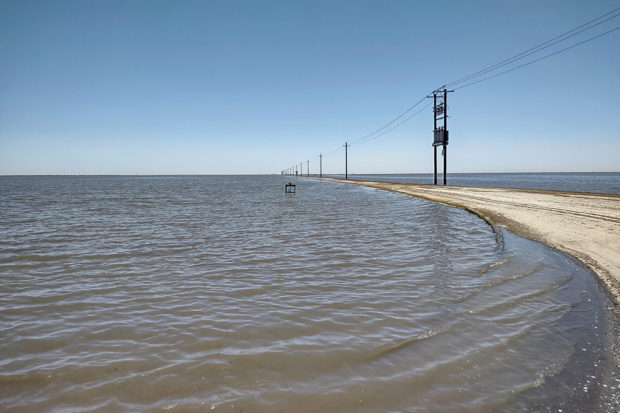
The emergence of a reborn Tulare Lake, from winter floodwaters that submerged farmland in the San Joaquin Valley, is posing new problems. The lake still covers an extensive landscape, but it is now slowly shrinking as water sinks into the ground and evaporates, becoming stagnant and warm—a welcoming host for pathogens.
State wildlife scientists found two birds stricken with avian botulism. It’s a common bird disease that thrives in stagnant water. And there are other hazards at Tulare Lake as well.
The rise of Tulare Lake in the wake of historic winter storms has become a conundrum. It’s not really a lake but rather engulfed farmland. Yet it is vast, with waterfowl and wildlife flocking to it.
Buried underneath the expansive Tulare Lake surface are mysteries that will have to be resolved as the water recedes over the next one or two years.
Sgt. Nate Ferrier is the public information officer for the Kings County Sheriff’s Office. He’s spent a lot of time dealing with the massive flood event that has re-created the lake.
At the peak, the lake rivaled Lake Tahoe in surface area, but Ferrier says it’s noticeably shrinking, “At its peak it was about 120,000 acres that was flooded. It has since dropped dramatically. It’s down to about 60,000 acres now…So it’s definitely shrinking down.
“But some of the things we’re seeing out there, obviously a lot of wildlife, a lot of different types of birds and animals that are out there, it’s pretty significant actually.”
Most, but not all, of the inundated farmland belongs to J.G. Boswell Company, by far Kings County’s largest landholder. The rich soil grows field crops such as safflower, cotton, tomatoes and alfalfa. But permanent crops like pistachio and almond trees grow there too.
So, the lakebed is a flooded industrial landscape—with depths of around seven feet, which is down from 40 feet earlier in the year. That means lurking underwater lies a multitude of decaying natural and man-made materials, and who knows what else.
“There’s certainly a lot of things that are still out in the water,” says Ferrier. “There’s tractors, cars, homes. So, in some places we were able to get some equipment out, but a lot of [it] unfortunately not.
“So, the water is dirty. I wouldn’t recommend drinking it. Our health department has been testing it regularly. There’s definitely some E. coli situations out there, but from what I’m being told, there’s really nothing super unusual or a major hazard at this point. So that’s good news.
“But yeah, there’s diesel fuel and there’s chemicals and just various things that you would find on a farm that are still out there.”
Tulare Lake is an example of the dangers flooding has on developed and industrialized communities in an era of climate change, as raging waters unearth toxins and debris during weather extremes that are forecast to be more common.
The water at Tulare Lake is also becoming a breeding ground for pathogens. The California Department of Fish and Wildlife (CDFW) has reported an incidence of avian botulism. They say it’s due to stagnant and warming water. The toxin was detected in a mallard duck and a white-faced ibis.
The agency is doing aerial and boat surveys to monitor the bird population and reveal die-offs. Dead and critically ill birds are collected as soon as possible to prevent the spread of the disease.
According to CDFW Senior Environmental Scientist Evan King, “Removing carcasses will be the first step of defense in preventing further spread. These are naturally occurring events to some degree and it’s likely some losses will occur, but we’re going to do everything we can to lessen the number of overall bird deaths caused by this illness.”
This is part of a combined effort by numerous state and local agencies to manage such a massive event. Wildlife officials expect the lake to attract many thousands of migratory waterfowl next winter.
Ferrier says the emergence and the ebbing of Tulare Lake has taught him a valuable lesson, “I’ve learned that Kings County can work together in a huge disaster.
“In this particular case, a lot of agencies have worked really well together and have come together for the ultimate end of protecting the larger space. It’s been such a great thing to see so many people work together so well.”
The partnership of agencies that has coalesced in response to the flooding of the Tulare Basin will continue to work together, as the coming El Niño weather pattern is expected to bring another wet winter.


I agree great contribution and participation by all agencies to keep the impact to a minimum of zoological diseases and destruction.